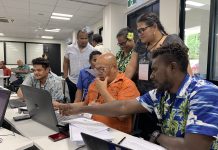Oped by Kanni Wignaraja and Munkhtuya Altangerel
A drive from Suva to the village of Tavuya, in Fiji, gives the onlooker a front row seat to climate adaptation works in action. Less than an hour’s journey from the bustling capital city of Suva, Tavuya still feels like a world away. For residents here, marine transport represents a lifeline, connecting its small population with essential services like schools, health clinics, markets, and jobs.
In recent years, the village has been battered by bigger-than-normal high tides and flash floods, linked to the climate crisis. Making it an existential matter to mitigate some of the effects of intense climate change. And it is not alone.
Small island states around the world, but particularly in the Pacific, are facing similar challenges – climate-induced disasters threaten their very existence. Tavuya and many coastal communities are not sitting helpless and idle. Against overwhelming odds and with scarce resources, they are drawing on their ancestral knowledge and can-do spirit to withstand the wrath of nature’s forces unleashed.
In Tavuya, with UN Development Programme’s (UNDP) support, citizens have mobilised to build resilience by making simple but surprisingly efficient structural adjustments to the way footbridges, jetties, and shelters are built. This ‘climate proofing’ of rural small infrastructure is co-designed and led by local workers, and they often withstand the next flood or mudslide. This result has not gone unnoticed.
Recognising that investment in resilient local infrastructure reduces climate and disaster risk – saving lives and money – Fiji’s Ministry of Rural and Maritime Development and Disaster Management is making systemic changes in how they develop infrastructure works and implement the delivery of services in towns and villages across the country.
This ‘risk-informed’ development approach has communities leading in the development of adaptation measures on land and on the water. The government has upgraded standard operational procedures around the design, implementation, and monitoring of all civil works and assets, and attempts to pair international climate finance with Fiji’s domestic budget to leverage and use available finances more effectively.
In collaboration with Australia, New Zealand, Sweden, Korea, and the United Kingdom providing financing, and with UNDP leveraging these bilateral and vertical funds and supporting the implementation of this integrated approach, the government has expanded efforts to deliver on close to 90 adaption-based community development projects in Fiji, including the one in Tavuya.
This is not how it always works. Too often, global climate financing comes with heavy administrative procedures, which puts it out of reach for most national governments and communities. These are the very communities that need these monies the most. Climate finance needs a special window for community-centred investments, that are more accessible and are particularly attuned to the risks and needs of small island states and territories.
In recent years, there has been an overall increase in climate financing for Pacific Island countries, particularly through the three flagship funding mechanisms of the United Nations Framework Convention on Climate Change (UNFCC): The Green Climate Fund, the Global Environment Facility, and the Adaptation Fund. Since 2021, a total of US$3.5 billion had been allocated to climate-related projects, along with Overseas Development Assistance (ODA), which is a US$1 billion increase in support to the region over a ten-year period (2008-2018). This is not nothing. But let us put it in perspective – All Small Island Developing States (SIDS) together only receive about three percent of global climate finance. This is insufficient to make a dent in the climate threats faced by many of these small islands, that threaten their very existence.
Specific targeted windows for SIDS, based on vulnerability measures and not the current income categorisation that penalises those in the middle-income category, will help significantly. Integrating the cost of combating climate change into public and private sector projects and services, including risk and insurance coverage, could help ameliorate and absorb costs otherwise borne by vulnerable poor communities. The longer-term economic benefits of such climate-aware investments can be demonstrated in terms of lives saved, improved livelihoods and public health, and savings generated through safeguarding nature-based and community assets.
Development assistance can invest in the ingenuity and innovation capabilities of society, to come up with and test local solutions. Larger global and national budgets can then help scale what works and build up a market ecosystem that supports an all-of-island climate adaption response. This will also drive more ambitious and proactive partnerships, including with private sector, and peer-to-peer learning networks across the Pacific.
When COP 28 convenes in Dubai at the end of November, a central focus will be on climate financing. Fiji’s voice and actions can lead by example.

Kanni Wignaraja is UN Assistant Secretary General and UNDP Regional Director for Asia and the Pacific; and Munkhtuya Altangerel is UNDP Resident Representative for the Pacific Multi-Country Office
SOURCE: UNDP/PACNEWS


















